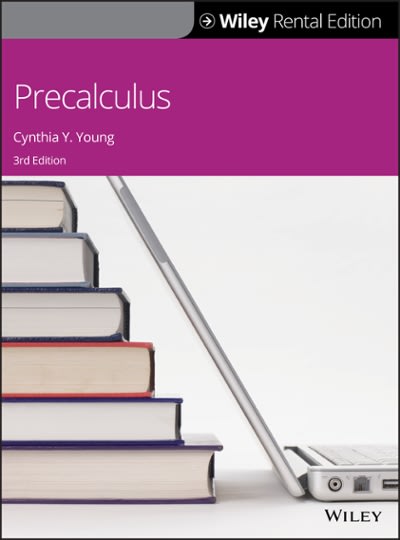Question
1. In June 2005, a survey was conducted in which a random sample of 1,464 U.S. adults was asked the following question: In 1973 the
1. In June 2005, a survey was conducted in which a random sample of 1,464 U.S. adults was asked the following question: "In 1973 the Roe versus Wade decision established a woman's constitutional right to an abortion, at least in the first three months of pregnancy. Would you like to see the Supreme Court completely overturn its Roe versus Wade decision, or not?"
The results were: Yes30%, No63%, Unsure7%(Source: www.Pollingreport.com)
Which of the following is true?
30%, 63%, and 7% are all parameters.
30%, 63%, and 7% are all statistics.
If another random sample of size 1,464 U.S. adults were to be chosen, we would expect to get the exact same distribution of answers.
Both (A) and (C) are correct.
Both (B) and (C) are correct.
The next three questions refer to the following information:
A social scientist wishes to conduct a survey. She plans to ask a yes/no question to a random sample from the U.S. adult population. One proposal is to select 100 people; another proposal is to select 900 people.
2. Which of the following is true regarding the sample proportion p-hat, of "yes" responses?
The sample proportion from the sample of 900 is more likely to be close to the true population proportion, p.
The sample proportion from sample of 100 is more likely to be close to the true population proportion, p.
The sample proportion in either proposal is equally likely to be close to the true population proportion, p, since the sampling is random.
It is impossible to say one way or the other.
3. If the study were conducted over and over (selecting different samples of people each time), which one of the following would be true regarding the resulting sample proportions of "yes" responses?
Different sample proportions would result each time, but for sample size 900 they would be centered (have their mean) at the true population proportion, whereas for sample size 100 they would not.
Different sample proportions would result each time, but for sample size 100 they would be centered (have their mean) at the true population proportion, whereas for sample size 900 they would not.
Different sample proportions would result each time, but for either sample size, they would be centered (have their mean) at the true population proportion.
For either sample size, using the same size each time, as long as the sampling is donewith replacement, their mean would be 0.
None of the above is true, since it makes no sense to talk about themeanof sample proportions.
4. Which one of the following is true regarding the standard deviation of the sampling distribution of the sample proportion, p-hat, of "yes" responses?
The standard deviation of the sampling distribution will be 9 times smaller with sample size 100.
The standard deviation of the sampling distribution will be 9 times larger with sample size 100.
The standard deviation of the sampling distribution will be 3 times smaller with sample size 100.
The standard deviation of the sampling distribution will be 3 times larger with sample size 100.
The standard deviation of the sampling distribution will be the same for both sample sizes.
5. The sampling distribution of a statistic is (select the best answer):
The mechanism that determines whether the random sampling was effective.
A curve, for which probabilities are obtained by standardizing.
A distribution of all parameters from the population that is to be randomly sampled.
A distribution of a single statistic from repeated random samples of the same size, from the same population.
A distribution of all possible summary statistics from a single random sample, from the same population.
6. Suppose that 20% of the residents in a certain state support an increase in the property tax. An opinion poll will randomly sample 400 state residents and will then compute the proportion in the sample that support a property tax increase.
How likely is the resulting sample proportion to be within .04 of the true proportion (i.e., between .16 and .24)?
(Hint: Use the sampling distribution of the sample proportion in this case.)
It is that the resulting sample proportion will be within .04 of the true proportion.
There is roughly a 99.7% chance that the resulting sample proportion will be within .04 of the true proportion.
There is roughly a 95% chance that the resulting sample proportion will be within .04 of the true proportion.
There is roughly a 68% chance that the resulting sample proportion will be within .04 of the true proportion.
Step by Step Solution
There are 3 Steps involved in it
Step: 1

Get Instant Access to Expert-Tailored Solutions
See step-by-step solutions with expert insights and AI powered tools for academic success
Step: 2

Step: 3

Ace Your Homework with AI
Get the answers you need in no time with our AI-driven, step-by-step assistance
Get Started


